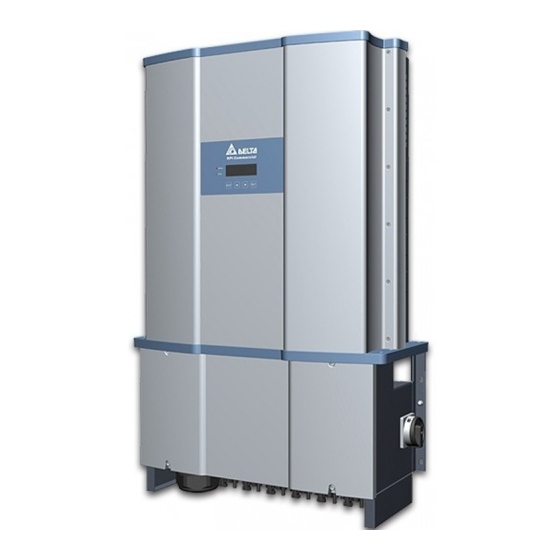
Summarization of Contents
1 Safety
1.1 Information of the Inverter
Details about the inverter, including disclaimers and target audience.
1.1.1 Disclaimer
Legal notice regarding product use and warranty conditions.
1.1.2 Target Group
Identifies the intended users and their required skills for safe operation.
1.2 General Safety
Important safety instructions and precautions for operating the inverter.
1.2.1 Condition of Use
Outlines specific operating conditions and limitations, including no galvanic isolation.
1.2.2 Symbols
Explains the meaning of safety symbols used throughout the manual.
2 Introduction
2.1 Valid Model
Lists the specific inverter models covered by this manual.
2.2 Product Overview
Provides a general overview of the inverter's components and features.
3 Installation
3.1 Mechanical Installation
Details the physical mounting procedures and requirements for the inverter.
3.2 Wiring box cover
Instructions for handling the wiring box cover during installation or maintenance.
3.3 Electrical Installation for AC Cabling
Guides on connecting the AC power cables to the inverter.
3.3.1 Required Protective Devices and AC Cabling Installation for M88H_121
Specifics for AC cabling and protective devices for the M88H_121 model.
3.3.2 Required Protective Devices and AC Cabling Installation for M88H_122
Specifics for AC cabling and protective devices for the M88H_122 model.
3.4 Electrical Installation for DC Cabling
Guides on connecting the DC power cables from the solar array.
3.4.1 DC Cabling Installation for M88H_121
Specifics for DC cabling for the M88H_121 model.
3.4.2 DC Cabling Installation for M88H_122
Specifics for DC cabling for the M88H_122 model.
3.5 Communication Module Connections
Details how to connect communication modules for data transfer.
3.5.1 RS-485 Connection
Instructions for setting up the RS-485 communication interface.
3.5.2 EPO Function & Digital Input
Configuration of the Emergency Power Off and digital input functions.
3.5.3 Dry Contact connection
How to connect dry contact interfaces for external signaling.
3.6 On-site insulation test
Procedure for performing an insulation test on-site.
4 Commissioning
4.1 Display Introduction
Overview of the inverter's LCD display and LED indicators.
4.2 First startup
Steps for initial setup and startup after installation.
4.2.1 Home Page
Description of the main display screen after initial startup.
4.3 Power meter / String monitoring
How to monitor power generation from AC and DC sides.
4.4 Energy Log
Viewing historical energy production data.
4.5 Event Log
Accessing logs of system events, errors, and faults.
4.6 Inverter Information
Displays serial number, firmware version, and other key inverter details.
4.7 General Settings
Configuration options for language, date/time, communication, and fan tests.
4.8 Install Settings
Advanced settings requiring a password, covering various operational parameters.
4.8.1 Inverter ID
Setting a unique ID for each inverter in a multi-inverter system.
4.8.2 Insulation
Configuration for insulation measurement methods and limits.
4.8.3 Grid Code
Selecting the appropriate grid code based on local regulations.
4.8.4 Grid Settings
Adjusting voltage and frequency protection parameters according to grid codes.
4.8.5 Dry Contact
Configuring the trigger conditions for dry contact outputs.
4.8.6 Anti-PID function
Settings for the Anti-Potential Induced Degradation function.
4.8.7 EPO
Configuration of the Emergency Power Off detection methods.
4.8.8 AC connection
Selecting the correct AC wiring type (3P3W or 3P4W).
4.8.9 Max. Power
Setting a limit on the inverter's maximum power output.
4.9 Active/Reactive Pwr
Control modes for active and reactive power output.
4.9.1 Active Power Ctrl
Controls for managing active power output.
4.9.1.1 Power limit
Setting the maximum percentage of rated power the inverter can output.
4.9.1.2 Power vs frequency
Adjusting output power based on grid frequency changes.
4.9.1.3 P(V)
Controlling active power based on grid voltage levels.
4.9.2 Reactive power Ctrl
Controls for managing reactive power output.
4.9.2.1 Constant cosphi
Setting a fixed power factor (cosphi) for reactive power output.
4.9.2.2 Cosphi (P)
Adjusting reactive power based on active power output.
4.9.2.3 Constant Q
Setting a fixed percentage of reactive power to feed into the grid.
4.9.2.4 Q(V)
Controlling reactive power based on grid voltage.
4.9.3 Q setting 24/7 function
Enabling reactive power feed during night time with various control modes.
4.9.3.1 Q setting point
Setting a specific reactive power percentage for the 24/7 function.
4.9.3.2 Q(P)
Adjusting reactive power based on active power output for the 24/7 function.
4.9.3.3 Q(V)
Controlling reactive power based on grid voltage for the 24/7 function.
4.9.3.4 Q(T)
Scheduling reactive power feed using an external monitoring system.
4.10 FRT (Fault ride through)
Enabling the inverter to stay connected during grid voltage dips.
5 Maintenance
5.1 Removing and re-installing the Wiring Box (WB) cover
Step-by-step guide to safely remove and reinstall the wiring box cover.
5.1.1 Removing the WB cover
Detailed instructions for removing the wiring box cover.
5.1.2 Re-installing the WB cover
Detailed instructions for reinstalling the wiring box cover.
5.2 Replace Surge Protection Device (SPD)
Procedure for replacing AC and DC surge protection devices.
5.3 Smart Fans Replacement and Filters Cleaning
Instructions for replacing smart fans and cleaning filters.
5.4 De-Commissioning
Procedures for safely taking the inverter out of operation.
5.4.1 Disassemble the Wiring box compartment
Steps to disassemble the wiring box compartment.













Need help?
Do you have a question about the M88H and is the answer not in the manual?
Questions and answers